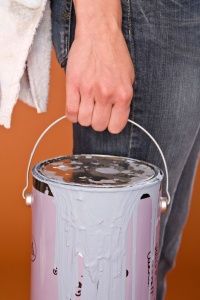You have two cans of 'Venetian Blue' satin paint, one labeled for exterior use and one labeled for interior use. Yes, both contain the same pigment and have the same sheen, and yes, of course they're both paint. But after those two similarities they begin to differ. If it's been years since you've taken on a paint job, things have changed in the paint aisle. The chemistry behind today's paint components fine-tunes them for their intended use, and both manufacturers and pros recommend you use each can as labeled -- interior paints inside and exterior paints outside.
First things first about paint: There are two basic types of paint to choose from, water-based and oil-based. Latex and acrylic paints are water-based, while alkyd paints are oil-based, and both interior paints and exterior paints come in both types. When it comes to exterior paint, oil-based is better at resisting dirt, but more commonly water-based latex paint is used because it tends to be at least as or more durable than oil-based. These outdoor-friendly paints are better suited to handle humidity, temperature changes and other outdoor factors, and they don't take as long to dry as alkyds. Paints formulated for outdoor use contain additives that give them longevity in the elements -- including resistance to cracking and dirt resistance, as well as protection from the damage ultraviolet (UV) rays cause. Many also have mildewcide as an additive.
Advertisement
Water-based paints are also preferred for indoor painting, and not just because of the fumes associated with oil-based paints. Instead of additives to crack down on dirt, interior paint’s chemistry is intended to make the paint hold up better against scuffs, scratches and sticking (for example, around window frames). It’s also designed to endure cleanings (such as removing the evidence of a tomato sauce splatter or scrubbing away a small child's artwork with an alkaline cleaner).
Additives are only one of four basic components of paint, though, and interior and exterior paints differ when it comes to the other three: pigment, binders and liquids.
Advertisement

